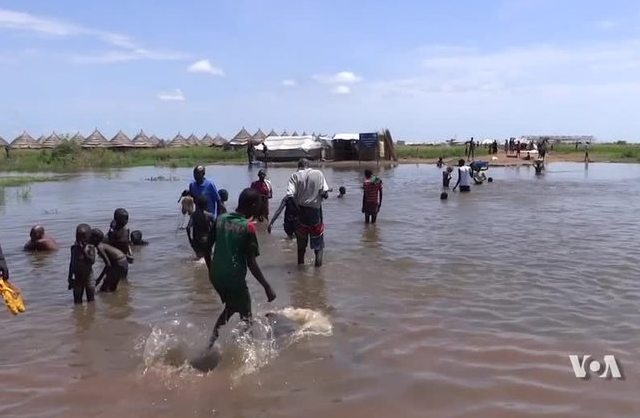 Gambella, Ethiopia. (Photo: VOA)
Gambella, Ethiopia. (Photo: VOA)
By Marthe van der Wolf
October 30th, 2014
Thousands of South Sudanese refugees remain stuck in flooded camps in Ethiopia. Marthe van der Wolf reports for VOA from a camp in Gambella on the situation.
—
Related:
Ethiopia’s South Sudan Refugees Beyond Capacity
VOA News
By Marthe van der Wolf
October 27, 2014
GAMBELLA — Available resources for South Sudan refugees in Ethiopia are under pressure as the warring parties continue to be deadlocked in flailing peace talks. More refugees are expected in the coming months as the conflict in the world’s youngest country turns almost a year old.
Since the conflict in South Sudan erupted in December, some 245,000 South Sudanese have fled to Gambella, a southwestern province of Ethiopia.
Pagak is one of the three main entry points used by refugees – who cross a bridge that functions as the border. Just after the bridge on the Ethiopian side, more than 2,700 refugees are waiting in the registration camp. And all of them need shelter, food and basic services.
Refugee Joseph Tek acts as camp leader on behalf of the refugee community. He said that people came to him with their needs, which he passed on to UNHCR, the UN Refugee Agency.
“They just need the mosquito net because of the mosquito bites. Plus they need food because in July we don’t have food here and we then receive food in August. And they feel cold because there is no blanket,” said Tek.
Nhial Yiech is a refugee who came to Ethiopia in March. He said they needed more services than what was provided.
He said they did’t have enough water, and medications. The diseases that affect people in this area are causing swollen throats, and many people have malaria.
Fighting continues since a political split between President Salva Kiir and his former deputy Riek Machar erupted into violence in the middle of December 2013. More than 10,000 people have died and more than 1.5 million have been displaced. Several agreed on cease-fires since then have failed to hold.
And there is little optimism that the violence in South Sudan will be halted any time soon, meaning refugees will keep coming to Ethiopia in need of relief. There are 18 aid organizations assisting refugees in the Gambella region. They say, that up till now, they had a good year with enough resources. But the situation is changing with unforeseen costs, mainly due to of flooding here.
Gebrehiwot Ewnetu is a project coordinator for the Danish Refugee Council. He said their donors have asked the organization to tighten its belt.
“So for example, DRC built 10 kilometers of reticulation, water piping for the refugees. Once they were forced to evacuate the camp, it meant we had to do new water points. We had to start water trucking again and transporting water by truck is extremely expensive. Other agencies also have the exact same problems with the flooding and people moving. For example, if you built a school in one place and people move, you have to build another school in another place, and things like that,” said Ewnetu.
The rainy season flooded roads and camps and temporarily slowed down the influx of refugees. But there are still 50 to 60 new arrivals every day at Akobo, another border point.
Dennis Solberg Kjeldsen, of the International Federation of the Red Cross, said that they were bracing for a new wave of displaced people.
“We are all expecting that once the rains subsiding in South Sudan, that will potentially mean the rise of conflicts and people wanting to go in search of food security. And where will they come? They will come here,” he said.
The rains are expected to stop in a few weeks’ time and organizations such as IFRC (International Federation of the Red Cross) are launching an international appeal to raise more funds. They estimate their basic running costs to be about $3 million over the next 6 months. Kjeldsen said raising money for South Sudan would not be easy.
“With the amounts of emergencies in the world right now. On this continent you have three very large emergencies: in South Sudan, in the Central African Republic, and Ebola. Which are not only taking up financial resources they are also taking up human resources, material resources. And that’s stretching us,” said Kjeldsen.
Just 3 years after independence, South Sudan’s political leaders are trying the international community’s patience. Many fault the government for prolonging a manufactured crisis and the development and aid money once flowing in is slowing down considerably.
And with that more displaced South Sudanese are leaving. Ethiopia is hosting more South Sudan refugees than any other African country.
—
Join the conversation on Twitter and Facebook.

























